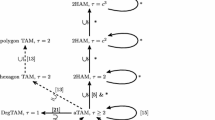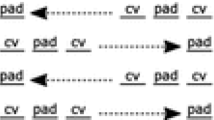Abstract
In the abstract Tile Assembly Model (aTAM), the phenomenon of cooperation occurs when the attachment of a new tile to a growing assembly requires it to bind to more than one tile already in the assembly. Often referred to as “temperature-2” systems, those which employ cooperation are known to be quite powerful (i.e. they are computationally universal and can build an enormous variety of shapes and structures). Conversely, aTAM systems which do not enforce cooperative behavior, a.k.a. “temperature-1” systems, are conjectured to be relatively very weak, likely to be unable to perform complex computations or algorithmically direct the process of self-assembly. Nonetheless, a variety of models based on slight modifications to the aTAM have been developed in which temperature-1 systems are in fact capable of Turing universal computation through a restricted notion of cooperation. Despite that power, though, several of those models have previously been proven to be unable to perform or simulate the stronger form of cooperation exhibited by temperature-2 aTAM systems. In this paper, we first prove that another model in which temperature-1 systems are computationally universal, namely the restricted glue TAM (rgTAM) in which tiles are allowed to have edges which exhibit repulsive forces, is also unable to simulate the strongly cooperative behavior of the temperature-2 aTAM. We then show that by combining the properties of two such models, the Dupled Tile Assembly Model (DTAM) and the rgTAM into the DrgTAM, we derive a model which is actually more powerful at temperature-1 than the aTAM at temperature-2. Specifically, the DrgTAM, at temperature-1, can simulate any aTAM system of any temperature, and it also contains systems which cannot be simulated by any system in the aTAM.















Similar content being viewed by others
Notes
Note that \(R^*\) is a total function since every assembly of S represents some assembly of T; the functions R and \(\alpha \) are partial to allow undefined points to represent empty space.
References
Cook M, Fu Y, Schweller RT (2011) Temperature 1 self-assembly: deterministic assembly in 3D and probabilistic assembly in 2D. In: SODA 2011: Proceedings of the 22nd annual ACM-SIAM symposium on discrete algorithms. SIAM
Demaine ED, Patitz MJ, Rogers TA, Schweller RT, Summers SM, Woods D (2013) The two-handed assembly model is not intrinsically universal. In: 40th International colloquium on automata, languages and programming, ICALP 2013, Riga, Latvia, July 8–12, 2013. Lecture Notes in Computer Science. Springer
Doty David, Kari Lila, Masson Benoît (2013) Negative interactions in irreversible self-assembly. Algorithmica 66(1):153–172
Doty D, Lutz JH, Patitz MJ, Schweller RT, Summers SM, Woods D (2012) The tile assembly model is intrinsically universal. In: Proceedings of the 53rd annual IEEE symposium on foundations of computer science, FOCS 2012, pp 302–310
Doty David, Patitz Matthew J, Summers Scott M (2011) Limitations of self-assembly at temperature 1. Theor Comput Sci 412:145–158
Hendricks J, Padilla JE, Patitz MJ, Rogers TA (2013) Signal transmission across tile assemblies: 3D static tiles simulate active self-assembly by 2D signal-passing tiles. In: Soloveichik D, Yurke B (ed) DNA computing and molecular programming, volume 8141 of Lecture Notes in Computer Science. Springer International Publishing, pp 90–104
Hendricks J, Patitz MJ, Rogers TA (2014) Doubles and negatives are positive (in self-assembly). CoRR, abs/1403.3841
Hendricks J, Patitz MJ, Rogers TA, Summers SM (2014) The power of duples (in self-assembly): it’s not so hip to be square. In: Proceedings of 20th international computing and combinatorics conference (COCOON 2014), Atlanta, Georgia, USA, 8/04/2014–8/06/2014. to appear
Lathrop James I, Lutz Jack H, Patitz Matthew J, Summers Scott M (2011) Computability and complexity in self-assembly. Theory Comput Syst 48(3):617–647
Meunier PE, Patitz MJ, Summers SM, Theyssier G, Winslow A, Woods D (2014) Intrinsic universality in tile self-assembly requires cooperation. In: Proceedings of the ACM-SIAM symposium on discrete algorithms (SODA 2014), (Portland, OR, USA, January 5–7, 2014), pp 752–771
Padilla JE, Patitz MJ, Pena R, Schweller RT, Seeman NC, Sheline R, Summers SM, Zhong X (2013) Asynchronous signal passing for tile self-assembly: fuel efficient computation and efficient assembly of shapes. In: UCNC, pp 174–185
Patitz MJ, Schweller RT, Summers SM (2011) Exact shapes and turing universality at temperature 1 with a single negative glue. In: Proceedings of the 17th international conference on DNA computing and molecular programming, DNA’11, Springer, Berlin, pp 175–189
Patitz Matthew J, Summers Scott M (2011) Self-assembly of decidable sets. Nat Comput 10(2):853–877
Rothemund PWK, Winfree E (2000) The program-size complexity of self-assembled squares (extended abstract). In: STOC ’00: Proceedings of the thirty-second annual ACM symposium on theory of computing, ACM, Portland, Oregon, United States, pp 459–468
Soloveichik David, Winfree Erik (2007) Complexity of self-assembled shapes. SIAM J Comput 36(6):1544–1569
Winfree E (1998) Algorithmic self-assembly of DNA. PhD thesis, California Institute of Technology
Acknowledgments
Jacob Hendricks and Matthew J. Patitz: Supported in part by National Science Foundation Grants CCF-1117672 and CCF-1422152. Trent A. Rogers: This author’s research was supported by the National Science Foundation Graduate Research Fellowship Program under Grant No. DGE-1450079, and National Science Foundation Grants CCF-1117672 and CCF-1422152.
Author information
Authors and Affiliations
Corresponding author
Rights and permissions
About this article
Cite this article
Hendricks, J., Patitz, M.J. & Rogers, T.A. Doubles and negatives are positive (in self-assembly). Nat Comput 15, 69–85 (2016). https://doi.org/10.1007/s11047-015-9513-6
Published:
Issue Date:
DOI: https://doi.org/10.1007/s11047-015-9513-6




